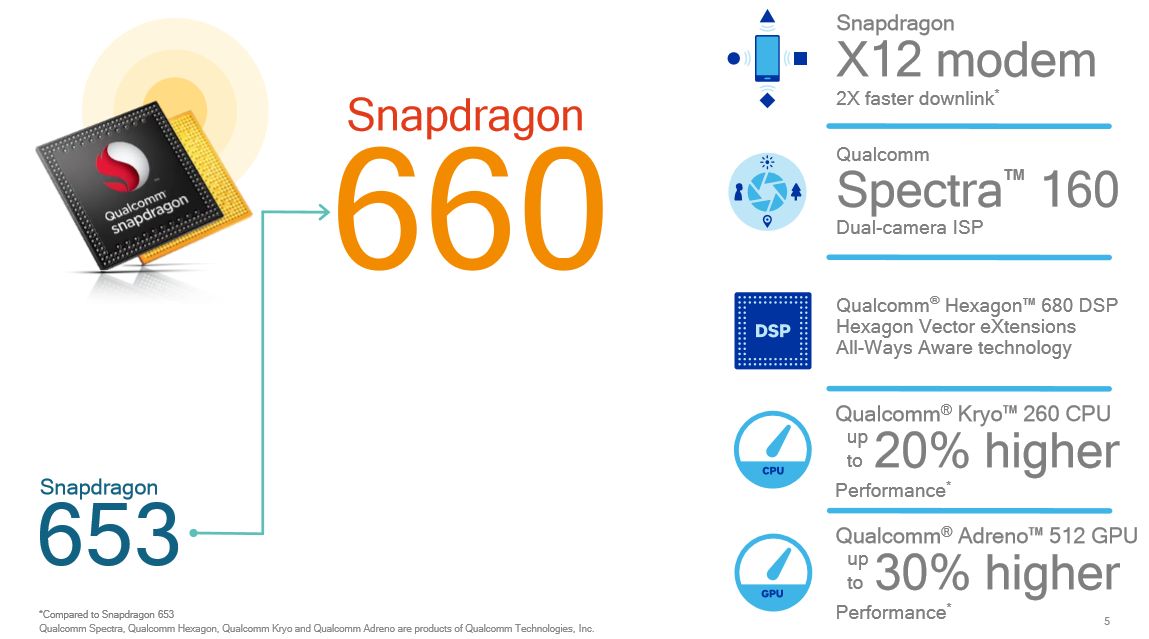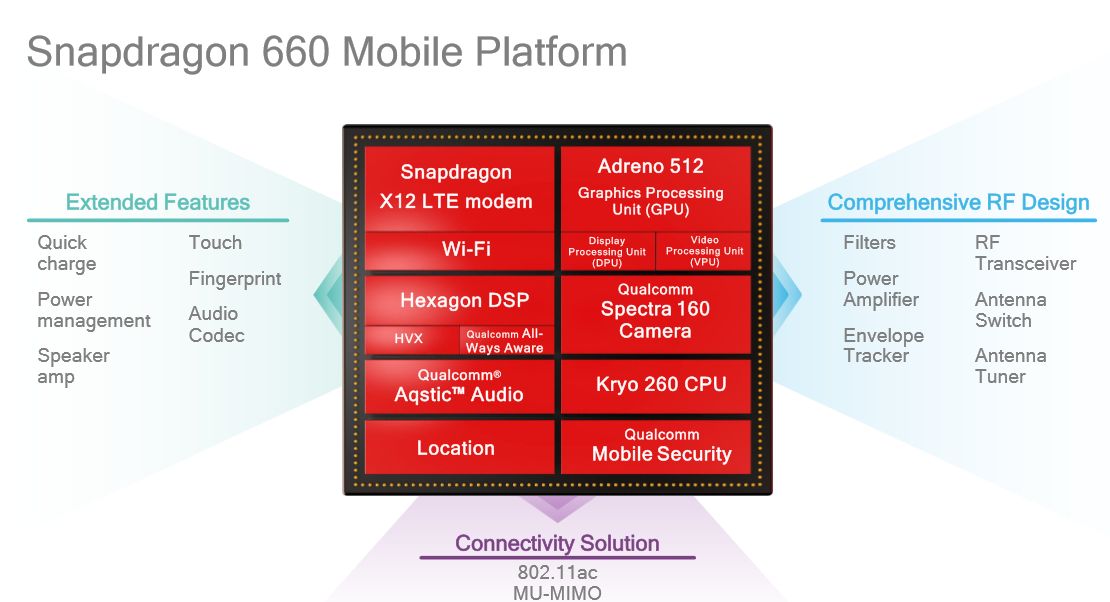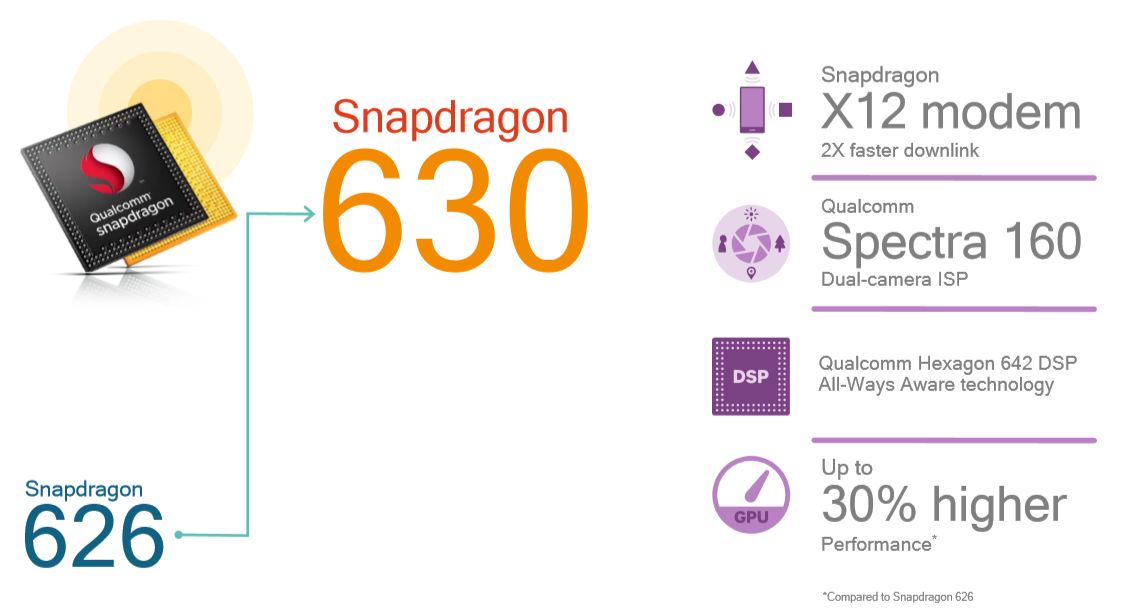The Snapdragon 660 will replace the Snapdragon 653 while the Snapdragon 630 replaces the Snapdragon 626. Both new SoCs are manufactured in 14nm FinFET and are pin and software compatible with its predecessors.
Compared to Snapdragon 653, the new Snapdragon 660 has a 20 percent faster CPU and this is the first mainstream SoC to launch with Kryo cores. Qualcomm didn’t go into many details but it did reveal the new Kryo 260 cores. The Snapdragon 835 comes with Kryo 280 custom ARM based cores, and we can only assume that the Kryo 260 is the variation of the core. Since the Snapdragon 660 is a 14nm SoC, we have a strong feeling that the Kryo 260 looks a lot like Snapdragon 820 Kryo cores.
The Kryo 260 performance quad core cluster runs at up to 2.2 GHz and has 1MB L2 cache while the efficiency cluster of Kryo 260 cores runs at up to 1.8 GHz and has 1MB L2 cache.
The GPU got a real boost - you can expect to see 30 percent faster performance from Adreno 512 compared to a Snapdragon 653 GPU.
The new mainstream SoC supports Snapdragon X12 modem with Cat 13 uplink and Cat 12 downlink support. Mainstream phones powered with this SoC will be able to match iPhone 7 top modem capabilities with speeds of up to 600 Mbps download and 150 Mbps upload.
The modem supports 3x20 MHz carrier aggregation, 256-QAM and up to 4x4 MIMO on one carrier.
On the uplink side, it supports Qualcomm Snapdragon Upload+, 2x20 MHz carrier aggregation, up to 2x 75Mbps LTE streams, 64-QAM and uplink data compression. Bear in mind that the Snapdragon X12 was first time revealed with Snapdragon 820 phones, and just one year later, this top speed technology is reaching mainstream phones.
It also supports 2x2 MU-MIMO 802.11ac Wi-Fi with speeds up to 867 Mbps, Hexagon 680 DSP, Spectra 160 Image signal processor for better photos and up to 8 GB 1866 MHz LPDDR4. Spectra 160 ISP is ready for dual camera mainstream phones and it supports PDAF autofocus and hybrid autofocus.
The Hexagon 680 DSP will help out in machine learning algorithms as it includes Snapdragon Neural Processing Engine SDK support. Machine learning and a SDK support is getting to the mainstream phones with TensorFlow and Caffe/Caffe2 frameworks support on Snapdragon 660 / 630 Hexagon DSP. Optimized software libraries include support for TensorFlow and Halide. Both platforms also support Qualcomm All-Ways Aware technology with support for the Google Awareness API.
This technology gives Qualcomm Technologies’ next generation of "always-on" contextual experiences and uses very low power running on the Hexagon DSP.
Quick Charge promises to charge your phone safely, much faster than before. Taking this standard to the mainstream will speed up adoption.
This is, again, the first mainstream chip to support the Bluetooth 5.0
The Qualcomm Snapdragon 630 also comes with Snapdragon X12 modem as well as Spectra 160 ISP but it has a modified Hexagon 642 with all aware technology. This is another octa core with four cores clocked at 2.2 GHz and four cores based on Cortex A53 clocked at 1.8 GHz. 
It comes with Adreno 508 that should be 30 percent faster than the Adreno with Snapdragon 626. The SoC supports 8 GB memory with 1333 MHz speed LPDDR4 as well as Snapdragon X12 modem.
The Snapdragon 660 is expected to ship to partners now while the Snapdragon 630 should start shipping toward the end of the month. You can expect to see them in the phone in the next quarter. These two are really stepping up the manistream game.




